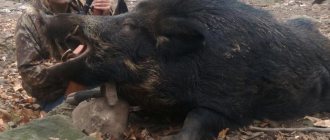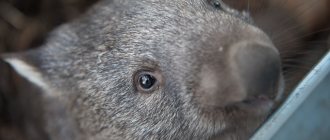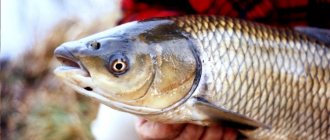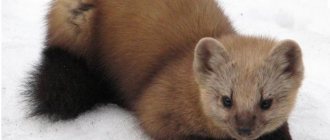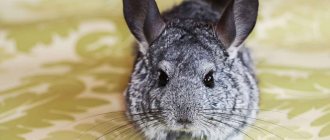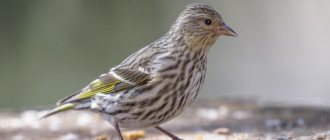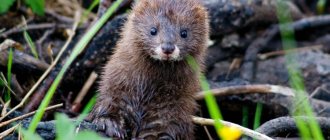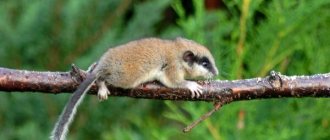The sable is a small but very agile predator from the mustelidae family. Representatives of the species prefer to settle in mixed forests consisting of conifers and deciduous trees with dense undergrowth. Populations are found in both flat and mountain areas.
Sables lead a sedentary life and pair up only for the breeding season. They rarely leave their area, but can migrate after food or when danger arises.
Origin of the species and description
Photo: Sobol
Findings by which one could trace the development of this species are very scarce. In the Miocene, a genus appeared to which the sable belongs. At that time, the predator lived in large areas in the west and south of Europe, in South-West and Central Asia, and in North America.
Forms close to modern ones exist in the Pliocene. Remains were found in the late Pleistocene in the Urals, Altai, Cisbaikalia, as far as Kamchatka and Sakhalin. Fossils are preserved in the Upper Pleistocene layers of the foothills of the Eastern Sayan Mountains and the river basin. Hangars. In the Tertiary period, due to the formation of new biocenoses, the division of mustelids occurred. At that time, the sable acquired characteristic features that distinguish it from other species of this family.
Video: Sable
In the early historical period, the habitat area extended from modern Finland to the Pacific Ocean. Between the Pleistocene and Holocene, during the retreat of glaciers and the appearance of forests, the animal left the area of the border of the glacial zone and settled in more favorable places. 20-40 thousand years ago the predator was found in the Urals, but did not reach high numbers in post-glacial times (8-11 thousand years ago).
The bones of the animal found in Altai are more than 100 thousand years old. In the Trans-Urals and Siberia, no remains older than 20 thousand years have been found, although this does not mean that mammals were not found in an earlier period. In the evolutionary development of the mustelid family, differentiation was based on differences in adaptation to the habitat, food supply and method of hunting.
Appearance and features
Photo: Animal sable
The predator looks like a marten, but anyone who has seen these related species will not confuse them, since the sable’s body and tail are shorter in proportion. The head is large with widely spaced and rounded ears. The paws are wide, five-toed, with hair on the soles.
In males:
- body weight – 1150-1850 g;
- body length – 32-53 cm;
- tail length – 13-18 cm;
- hair length – 51-55 mm;
- underfur length – 32-31 mm.
In females:
- body weight – 650-1600 g;
- body length – 32-53 cm;
- tail length – 12-16 cm;
- hair length – 46 mm;
- underfur length – 26-28 mm.
The mammal exhibits great geographic variability in body size, color, and fur quality. Based on these characteristics, there are descriptions of more than 20 geographical subspecies. The largest individuals are found in Kamchatka, Altai, and the Urals. The smallest ones are in the area of the Amur and Ussuri basins. Animals from the Urals have lighter fur, and the darkest fur is found in specimens found in the Baikal and Transbaikalia regions, the Amur region and Yakutia.
The winter fur of the predator is very fluffy, thick and silky. In summer, the animal looks longer and thinner, but its paws and head remain large. The color of the winter coat is one tone, from dark brown, almost black, to brown and fawn with a thick grayish underfur. The muzzle and ears are slightly lighter than the main color. On the throat there is a blurred, sometimes completely invisible, small spot of a yellowish or whitish color. In summer, the fur is not so thick and fluffy. It is darker in tone than winter. In some subspecies the tail is slightly darker than the main color.
Where does the sable live?
Photo: Sable in the snow
The fur-bearing animal is found in Russia, Kazakhstan, China, Mongolia, Japan and North Korea. Inhabits coniferous Siberian forests and the European northeast, crossing the Ural Mountains to the west. The distribution area is in the Altai and Western Sayan mountains. The southern border reaches 55° latitude in Western Siberia, and 42° in Eastern Siberia.
The range reaches the extreme southern points of the Korean Peninsula and the island of Hokkaido; the predator is found in Sakhalin. In Mongolia, it is distributed in the north-west of the country, around lake. Khubsugul. In Transbaikalia, where the harshest continental climate is, the most valuable subspecies of this animal lives in the forests. In eastern Kazakhstan, it inhabits the basins of the Uba and Bukhtarma rivers. In China there are in the north in the mountains of Southern Altai, in the northeast of the country - in Heilongjiang province, as well as on the Changbai Mountains. The habitat of the predator is an area of 5 million m2.
A representative of the mustelid family likes to settle in cedar forests, on mountain slopes, where there is a cedar shrub. It is here that there are many rodents, which are attracted by the abundance of food - pine nuts. The fluffy beauty can live in mountain and lowland taiga, where it prefers windbreaks and dead wood. The animal lives, but is found much less frequently, in small-leaved and pine forests, along clearings and burnt areas, and swampy places. On the Kamchatka Peninsula it settles in groves of stone birch, alder and cedar dwarf trees. In the mountains it can rise to the level of subalpine forests.
Popular message topics
- Golden Eagle Eagle
Golden Eagle is a bird of prey that is the largest among all eagles. Golden eagles live in the northern hemisphere of our planet in the mountains. In open and semi-open areas this bird can be found, but in very small numbers. - City of Arkhangelsk
The city of Arkhangelsk was founded by Ivan the Terrible VI. But these lands first appear in chronicles in 1419. In 1553, trade relations began to develop in this area. - Jan Hus
Every year on July 6, bonfires are lit throughout the Czech Republic - this is how the inhabitants of this country honor the memory of their national hero - Jan Hus. Why, after almost 650 years, do Czechs remember this man and consider him a hero?
What does a sable eat?
Photo: Sable in winter
This omnivorous predator hunts small mammals - they make up 60-80% of the diet. In addition to mice, voles and other rodents, which dominate its menu, it can hunt chipmunks, squirrels, hares, pikas, and muskrats. It also attacks mustelids: ermine, weasel. The mammal is able to follow the trail of wolves or bears for a long time and then share a meal with them. Near the carcasses of large animals that have become victims of other predators, the fur-bearing animal lives and feeds for several days.
In snowy years, when other prey is difficult to catch, the sable even hunts musk deer alone. And then several individuals gather for a feast near the prey, which is much larger than the predator. A small hunter attacks large animals when the harvest of cedar nuts and dwarf cedar fails (their share can reach 33-77%, depending on the presence or absence of other food sources). In summer it eats berries: rose hips, lingonberries, bird cherry, rowan (4-33%).
The share of birds, mainly grouse, accounts for 6-12%; it also catches smaller birds, destroying nests, eats eggs, amphibians, mollusks, insects, and does not disdain carrion. The Far Eastern sable eats fish after spawning. The predatory instincts of a mammal are reduced with an abundance of plant food. If there is not enough food, then he approaches human settlements. The animal needs food in an amount of at least 20% of its body weight, this is equal to the production of 6-8 vole mice per day.
Fishing
Sable is an animal valued for its very thick fur. Such wealth brought many troubles to the animal. Its skin is very valuable. It became known as “soft gold.” Consequently, these animals were constantly hunted. Because of this, its numbers have decreased significantly.
Hats and fur coats are made from its fur. The peoples of Siberia did not value sable fur and used it to cover the bottom of their skis. Local hunters tried to preserve the number of animals. It was hunted only once every 3 years so that the population could recover.
Features of character and lifestyle
Photo: Taiga animal sable
The animal is very dexterous and strong, tireless, with good hearing and excellent hunting skills. This allows him to find prey by identifying the object by smell and rustle. The animal is active at any time of the day or night, it all depends on the weather and the availability of food. In frosty weather it is able to stay in shelter for several days.
The sable is a terrestrial predator, although it easily climbs a tree, but is not capable of jumping from branch to branch. It moves well under snow cover and can thus evade pursuit, but hunts on the surface, and prefers to sit in ambush rather than pursue. The forest beauty moves in small jumps of 40-70 cm, but when escaping from pursuit, it can increase their length to 3-4 m.
This animal has a permanent home range of 4 to 30 km2, and also has several temporary habitats and hunting areas. The size of the site and activity depend on age, gender, weather conditions and climate, population density, and food availability. On average, he runs about 9 km per day.
Leading a sedentary lifestyle, the sable rarely leaves its refuge; it travels no further than 30 km from the marking sites. Adult individuals can undertake long-distance movements of up to 150 km, which take several months to overcome. He does not make a den for himself, but is looking for a suitable place for giving birth and raising cubs, as well as for the winter.
The dwelling is lined with dry grass, wool, lichen, feather, finding shelter:
- under the roots of fallen trees;
- in stumps;
- in dead wood;
- in stone placers;
- in hollows located low above the ground.
Temporarily, escaping from pursuit, it takes refuge in rock crevices, rocky outcrops, tree crowns or underground burrows. In winter it burrows under a deep layer of snow. The animal sheds twice a year: in the spring it begins in March and ends in May; in the fall this period lasts from August to November.
Lifestyle
The sable is a unique animal that leads a nomadic and sedentary lifestyle. The animal is attached to a specific area and rarely goes beyond its boundaries in its entire life. Forest fires, natural disasters, lack of food, and massive deforestation can only force the sable animal, interesting facts about whose life are given in this article, to leave its habitat.
The animal has a large number of temporary shelters and several permanent ones in its area. The latter are divided into winter and brood. It is characteristic of the sable that it does not build its own houses, but uses natural voids.
He chooses crevices between stones, niches under inversions, hollows in lying logs or trees. In winter, he makes his way to his nest under the snow. The animal does not hide its hole, which means it can be easily found by a huge number of tracks that converge in a common place.
Social structure and reproduction
Photo: Sobol
Sable is a loner by nature, he is polygamous. To mark territory, it uses scent glands, which are located on the back of the abdomen. The rut begins in July and ends in August. Gestation time lasts about 245-297 days. Of this period, seven months are in the latent stage, when the embryos do not develop. This nature of pregnancy is provided by nature so that the cubs appear at a more favorable time.
Newborns are born in April blind, with grayish sparse down. A litter can have from two to six babies. The length of the body is 11-12 cm, with a weight of 25-30 g. They begin to hear on the 22nd day, and by the month they become sighted, by the 38th day they have incisors. At 3-4 months, baby teeth are replaced by permanent ones. By 1.5-2 months. the babies begin to leave the nest, at about the same time they stop feeding on their mother’s milk and weigh about 600 g, and by September they reach the size of adults and begin independent life. Reproductive ability in a sable appears at the age of two years.
During rutting and courtship, animals make sounds similar to meowing and also grumble gutturally. When they are excited or unhappy, they purr, and to scare them, they chirp loudly. The lifespan of the animal in nature is about 8 years, in captivity on average up to 15-16 years, but cases have been recorded when some individuals lived up to 18-20 years, and females gave birth to offspring up to 13-14 years. The animal has interspecific trophic connections (eats or is prey) with 36 mammals, 220 birds, 21 plant species.
Natural enemies of sables
Photo: Animal sable
Our dexterous hunter himself often becomes the prey of larger predators.
These are the eight species of mammals:
- Brown bear;
- wolf;
- fox;
- lynx;
- arctic fox;
- wolverine;
- tigers;
- harza.
Eight species of birds also attack small animals:
- white-tailed eagle;
- golden eagle;
- crow;
- goshawk;
- sparrowhawk;
- great gray owl;
- hawk owl.
A sable can die not only from the teeth of predators, but also from a lack of food when there is fierce interspecific competition. It wages such a struggle for habitats and food supply with 28 species of mammals and 27 species of birds. One of the main enemies that almost destroyed this species of animal is man. In the 17th century, the Kamchadals exchanged with the Cossacks, who were developing lands on the eastern borders of Russia: they gave 8 sable skins for one knife, and 18 for an axe, not considering this fur valuable.
Restoration of numbers
While maintaining the number of the animal, attempts were made to breed it in nature reserves and then resettle it in other territories. This turned out to be a difficult task, since at first it was difficult to obtain offspring. It was necessary to study the habits of the animal, making a lot of effort for this.
When planning the reintroduction of an animal, it is necessary to carefully study the area where it was released, and also check whether it lived there before. A change of environment (fires, deforestation) is of great importance. After reintroduction in this area, fishing must be stopped for some time.
To determine the territory for the sable, the availability of a food base, nesting sites, the animal’s competitors and predators is crucial.
